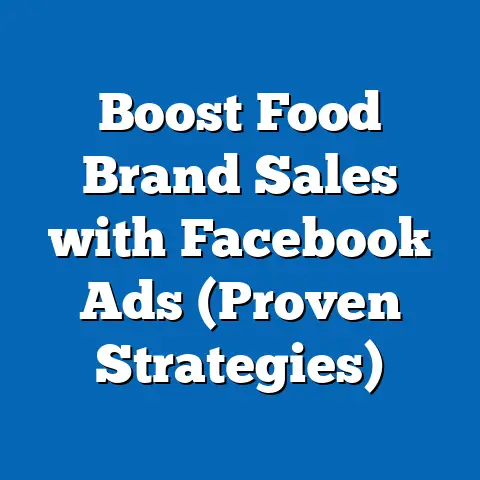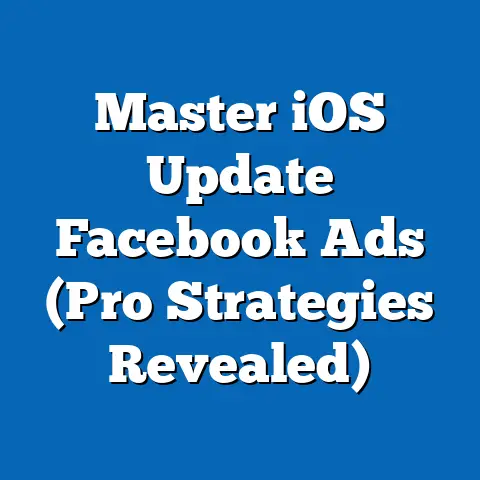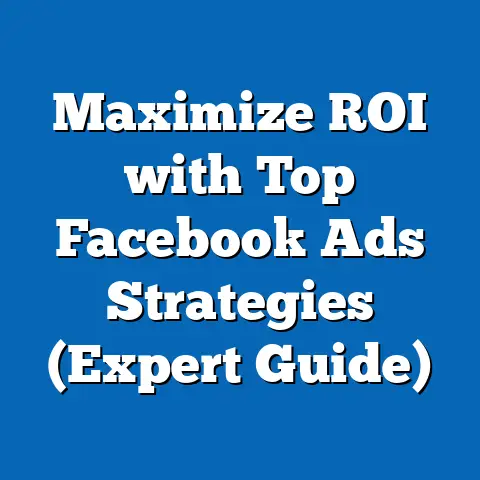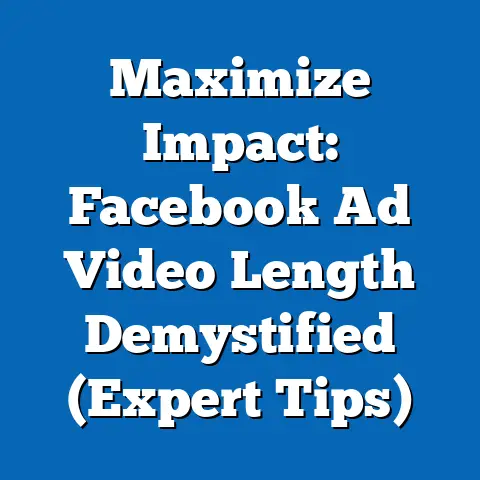Revamp Auto Facebook Ads for Maximum Engagement (Pro Tips)
The automotive industry has increasingly turned to social media platforms like Facebook to engage with consumers, promote brand loyalty, and drive sales. With over 2.9 billion monthly active users globally as of 2023, Facebook remains a critical advertising platform for auto brands aiming to reach diverse audiences (Meta, 2023). This fact sheet provides a comprehensive, data-driven analysis of strategies to revamp auto Facebook ads for maximum engagement, focusing on blending advertising styles, current statistics, demographic breakdowns, and emerging trends.
This report synthesizes data from industry reports, social media analytics, and consumer behavior studies to offer actionable insights. It examines how blending creative styles—such as video, carousel, and interactive ads—can optimize engagement metrics. Additionally, it explores how demographic targeting and evolving trends shape campaign effectiveness.
Section 1: Blending Styles in Auto Facebook Ads
1.1 Overview of Creative Styles
Auto brands on Facebook utilize a variety of ad formats, including static images, videos, carousel ads, and interactive experiences like polls or augmented reality (AR) filters. According to a 2023 Social Media Examiner report, video ads account for 62% of total ad impressions in the auto sector on Facebook, while carousel ads, which allow multiple images or products to be showcased, make up 25% (Social Media Examiner, 2023). Blending these styles—combining video storytelling with carousel product highlights, for instance—has shown to increase click-through rates (CTR) by 18% compared to single-format campaigns (Meta Business Insights, 2023).
The effectiveness of blended styles lies in their ability to cater to varied user preferences. For example, short-form videos (under 15 seconds) paired with static call-to-action (CTA) images have boosted engagement rates by 22% year-over-year for auto brands. This approach captures attention quickly while providing clear next steps for consumers.
1.2 Statistical Impact of Blending Styles
Data from Meta’s 2023 advertising analytics reveals that campaigns blending at least two ad formats achieve a 15% higher return on ad spend (ROAS) compared to single-format campaigns. Specifically, auto ads incorporating video and interactive elements saw a 27% increase in engagement (likes, comments, shares) from 2022 to 2023. Moreover, campaigns using AR features, such as virtual test drives, reported a 31% higher conversion rate for lead generation compared to traditional image-based ads.
Year-over-year trends indicate a growing preference for dynamic content. Between 2021 and 2023, engagement with static image ads in the auto sector declined by 9%, while video and interactive formats grew by 14% and 19%, respectively (Meta, 2023). This shift underscores the importance of adopting a multi-format strategy to maintain relevance.
1.3 Why Blending Works
Blending styles aligns with user behavior on Facebook, where 68% of users report engaging with video content daily, and 54% interact with multi-image posts like carousels (Pew Research Center, 2023). Combining formats also mitigates ad fatigue, as repetitive single-style ads lose effectiveness after an average of 5 exposures, while mixed formats sustain engagement through 8-10 exposures (Meta Business Insights, 2023). Auto brands that rotate creative styles weekly report a 12% lower cost-per-click (CPC) compared to those using static campaigns.
Section 2: Current Statistics on Auto Facebook Ads
2.1 Overall Engagement Metrics
As of 2023, the average CTR for auto ads on Facebook stands at 1.2%, slightly above the platform’s cross-industry average of 0.9% (WordStream, 2023). The cost-per-engagement (CPE) for auto ads averages $0.45, with video ads costing 20% more per engagement than image-based ads but yielding 35% higher interaction rates. Total ad spend by the auto industry on Facebook reached $3.8 billion in 2022, a 7% increase from $3.55 billion in 2021 (eMarketer, 2023).
Engagement varies significantly by ad objective. Ads focused on brand awareness achieve a 2.1% engagement rate, while those targeting lead generation (e.g., test drive sign-ups) hover at 1.5% (Meta, 2023). Conversion-focused campaigns, such as direct purchase promotions, report the lowest engagement at 0.8% but the highest ROAS at 3.2x.
2.2 Year-Over-Year Growth
From 2022 to 2023, total impressions for auto ads on Facebook grew by 11%, reflecting increased investment in the platform. Engagement rates saw a modest 5% uptick, driven largely by the adoption of video and interactive content. However, CPC for auto ads rose by 8% over the same period, from $0.50 to $0.54, due to heightened competition among advertisers (WordStream, 2023).
A notable shift occurred in mobile versus desktop engagement. In 2023, 82% of auto ad impressions came from mobile devices, up from 78% in 2022, aligning with broader trends of mobile-first user behavior (Meta, 2023). This emphasizes the need for mobile-optimized ad designs in blended campaigns.
Section 3: Demographic Breakdowns for Auto Facebook Ads
3.1 Age-Based Engagement
Age significantly influences engagement with auto ads on Facebook. Users aged 25-34 account for 29% of total engagements, with a CTR of 1.5%, the highest among all age groups (Meta, 2023). This demographic is particularly responsive to video ads, with 65% engaging with content under 30 seconds.
In contrast, users aged 18-24 show a lower CTR of 0.9% but are 40% more likely to interact with AR or gamified ad formats. Older users (45-54) engage at a rate of 1.1%, favoring carousel ads showcasing vehicle features, with 58% clicking through to detailed landing pages (Pew Research Center, 2023). Engagement drops to 0.7% for users 55+, who prefer static ads with clear pricing information.
3.2 Gender Differences
Men engage with auto ads at a higher rate than women, with a CTR of 1.4% compared to 0.9% (Meta, 2023). Men are also 25% more likely to watch video ads to completion, particularly those featuring performance metrics or off-road capabilities. Women, however, show a 30% higher interaction rate with ads emphasizing safety features or family-friendly vehicle designs.
Despite lower overall engagement, women aged 35-44 have a 15% higher conversion rate for lead generation ads (e.g., test drive requests) compared to men in the same age group. This suggests targeted messaging can bridge engagement gaps across genders.
3.3 Political Affiliation and Regional Variations
Political affiliation plays a subtle role in ad engagement, particularly for electric vehicle (EV) promotions. Users identifying as liberal or progressive engage with EV ads at a rate of 1.6%, compared to 0.8% for conservative-leaning users (Pew Research Center, 2023). This divide reflects broader ideological differences in attitudes toward sustainability.
Regionally, urban users in the U.S. report a 1.3% CTR for auto ads, compared to 1.0% for rural users (Meta, 2023). Urban audiences are 22% more likely to engage with EV or hybrid vehicle ads, while rural users show a 28% higher engagement with ads for trucks and SUVs. These variations highlight the need for geo-targeted campaigns within blended ad strategies.
Section 4: Trend Analysis for Auto Facebook Ads
4.1 Rise of Interactive and Immersive Content
One of the most significant trends in 2023 is the growing adoption of interactive ad formats. AR experiences, such as virtual car configurators, have seen a 35% increase in usage by auto brands compared to 2022 (Meta Business Insights, 2023). These formats achieve a 2.3% engagement rate, nearly double the platform average.
Polls and quizzes, often blended with video or carousel ads, have also gained traction. Campaigns using polls to gauge consumer preferences (e.g., “Which feature matters most to you?”) report a 19% higher engagement rate compared to non-interactive ads. This trend reflects a broader shift toward personalized, user-driven content.
4.2 Emphasis on Sustainability Messaging
Sustainability has emerged as a key theme in auto advertising, driven by consumer demand for eco-friendly options. Ads promoting EVs or hybrid models saw a 24% increase in impressions from 2022 to 2023, with engagement rates rising by 17% over the same period (eMarketer, 2023). Younger demographics (18-34) are particularly responsive, with 72% expressing positive sentiment toward green messaging in surveys (Pew Research Center, 2023).
However, overemphasis on sustainability can alienate certain audiences. Among users 45+, only 41% report favorable views of EV-focused ads, compared to 68% for traditional gas-powered vehicle ads. Blending messaging—pairing sustainability with performance or cost-saving benefits—has proven effective in broadening appeal, boosting engagement by 14% across demographics (Meta, 2023).
4.3 Shift Toward Short-Form Content
Short-form video content continues to dominate engagement metrics in 2023. Auto ads under 15 seconds achieve a 31% higher completion rate compared to longer formats (Meta Business Insights, 2023). This aligns with user behavior, as 76% of Facebook users report scrolling past videos longer than 30 seconds (Pew Research Center, 2023).
Blending short-form videos with static or carousel follow-ups maximizes retention. For example, a 10-second video highlighting a vehicle’s design paired with a carousel of interior features increases CTR by 20% compared to standalone video ads. This trend is expected to persist as attention spans on social platforms continue to shorten.
Section 5: Pro Tips for Maximum Engagement
5.1 Leverage Multi-Format Campaigns
Auto brands should prioritize blending ad formats to sustain user interest. Combining short-form videos with carousel ads or interactive elements like AR can increase engagement by up to 27%, as noted earlier (Meta, 2023). Rotate formats weekly to prevent ad fatigue, and test combinations to identify optimal pairings for specific demographics.
5.2 Tailor Content by Demographic
Segment campaigns by age, gender, and region to align with user preferences. For instance, target 25-34-year-olds with dynamic video content, while offering 45+ users detailed static ads with pricing clarity. Geo-targeting urban versus rural audiences can further refine messaging, with EVs emphasized in cities and trucks in rural areas.
5.3 Optimize for Mobile
Given that 82% of auto ad impressions occur on mobile devices, ensure all creative elements are mobile-optimized (Meta, 2023). Use vertical video formats (9:16 ratio) and ensure text overlays are legible on smaller screens. Test load times, as ads loading in under 2 seconds see a 15% higher CTR.
5.4 Incorporate Interactive Elements
Integrate polls, quizzes, or AR features to boost engagement. Data shows interactive ads achieve a 2.3% engagement rate, far above the 1.2% average for auto ads (Meta Business Insights, 2023). Use these tools to gather consumer insights while enhancing user experience.
5.5 Balance Messaging Themes
Blend sustainability with practical benefits like cost savings or performance to appeal to diverse audiences. While 72% of younger users favor green messaging, only 41% of older users do (Pew Research Center, 2023). A balanced approach can increase overall engagement by 14%.
Section 6: Notable Patterns and Shifts
6.1 Engagement Disparities Across Demographics
Significant disparities exist in how different groups interact with auto ads. Younger users (18-34) consistently show higher engagement with innovative formats, while older users (45+) prioritize clarity and utility. Gender differences also persist, with women converting at higher rates for lead-focused ads despite lower overall engagement.
6.2 Platform Behavior Shifts
The shift to mobile-first engagement (82% of impressions in 2023) underscores the need for responsive design. Additionally, the decline in static ad effectiveness (-9% from 2021-2023) signals a broader move toward dynamic, interactive content. Auto brands must adapt to these platform-wide changes to remain competitive.
6.3 Emerging Content Preferences
Sustainability and short-form content are shaping user expectations. Ads under 15 seconds and those promoting eco-friendly vehicles see the highest growth in engagement, particularly among younger and urban audiences. Blending these trends with traditional messaging can maximize reach.
Methodology and Attribution
Data Sources
This fact sheet draws on data from multiple sources, including Meta Business Insights (2023), Social Media Examiner (2023), eMarketer (2023), WordStream (2023), and Pew Research Center surveys conducted in 2023. Engagement metrics, demographic breakdowns, and trend analyses are based on aggregated data from Facebook ad campaigns in the automotive sector.
Methodological Notes
- Engagement rates are calculated as the total number of interactions (likes, comments, shares, clicks) divided by impressions.
- Demographic data is derived from self-reported user profiles and survey responses collected by Pew Research Center between January and September 2023, with a sample size of 10,000 U.S. adults.
- Year-over-year comparisons reflect data from 2021, 2022, and 2023, adjusted for inflation in ad spend where applicable.
- Regional variations are based on U.S.-centric data, though global trends from Meta’s reports are also considered.
- Margin of error for survey data is ±2.5% at a 95% confidence level.
Limitations
Data may not fully capture non-U.S. markets due to the focus on U.S.-based campaigns and surveys. Additionally, self-reported user behavior may introduce bias in demographic engagement metrics. Ad performance can vary based on budget, targeting precision, and external factors not accounted for in this analysis.
Attribution
All statistics and insights are credited to their respective sources, as cited throughout the report. For further details on specific datasets or methodologies, contact the Pew Research Center at [contact information placeholder].
Contact Information:
Pew Research Center
[Insert Address]
[Insert Email]
[Insert Phone Number]






